Looking for Global training? Go to https://firebrand.training/en or stay on the current site (United Kingdom)
TERMS AND CONDITIONS
Firebrand Training grants you a personal, non-exclusive, non-transferable license to access and use the site. You may download or print material from the site only for your own personal, non-commercial use. Please read our full terms and conditions.
7.4 Control Costs
"The process of monitoring the status of the project to update project costs and managing changes to he cost baseline."
The definition shown above in italics is taken from the Glossary of the Project Management Institute, A Guide to the Project Management Body of Knowledge, (PMBOK® Guide) – Fifth Edition, Project Management Institute Inc., 2013
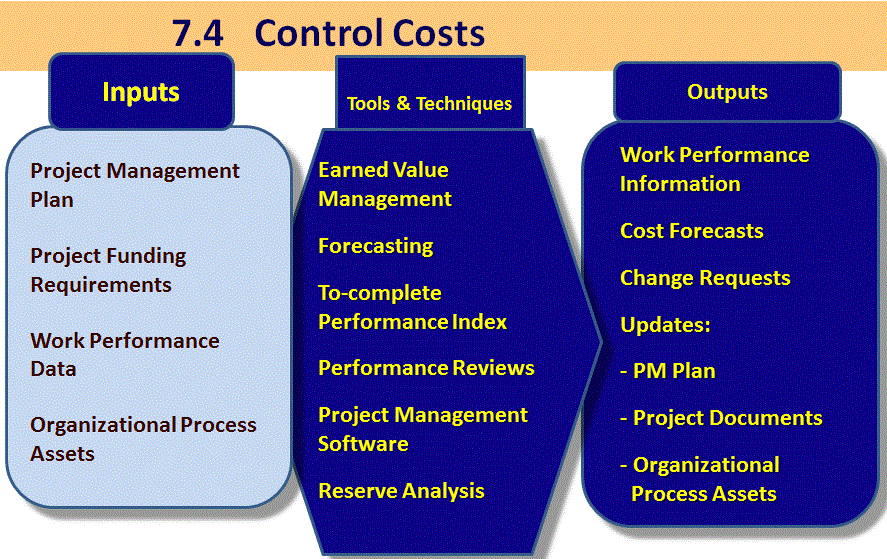
Project Management Institute, A Guide to the Project Management Body of Knowledge, (PMBOK® Guide) – Fifth Edition, Project Management Institute Inc., 2013 Figure 7-10 Page 215
Cost Control
Change Control System for Cost
- Integrated with the Integrated Change Control Process
- Documented in the Cost Management Plan
- Any increase in the authorised budget can only be approved through 4.5 Perform Integrated Change Control process
Project cost control requires:
- Monitoring cost performance
- Ensuring that only appropriate project changes are included in a revised cost baseline
- Informing project stakeholders of authorized changes to the project that will affect costs
Earned Value Analysis (or Earned Value Management (EVM) is an important way to control costs
Earned Value Management (EVM)
- Measures project progress as well as forecast cost at completion
- Compares actuals for schedule and cost performance against planned performance
- Quite important to understand the monetary value of work completed
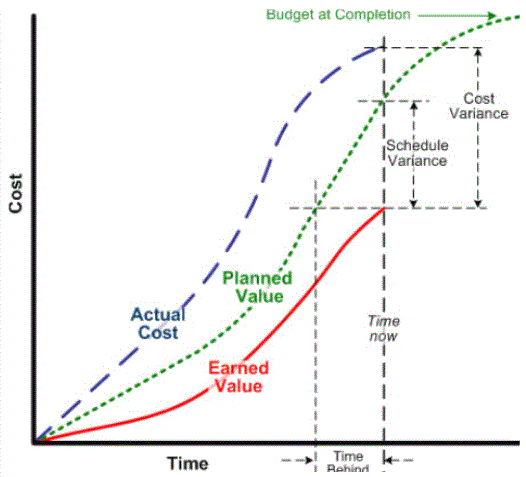
Questions from the Sponsor:
- What percentage of the work is complete?
- Where is my money going?
- How much did we spend so far compared with what we budgeted (the forecast)?
- What percentage of the work is complete?
- Why are we behind schedule?
- What is your estimate at completion?
Earned Value concepts
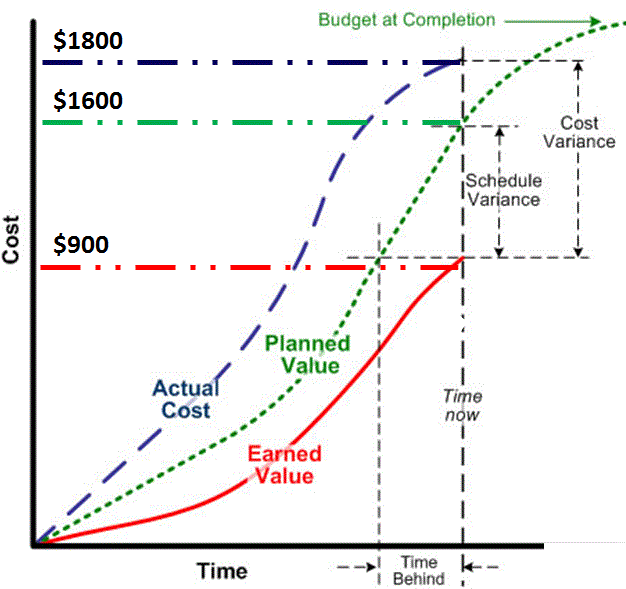
Planned Value = the estimated cost of what we planned to do at report point
Total PV = BAC = PMB (Performance Measurement Baseline)
Earned Value = the estimated cost of the work that was done at report point = PV x progress
Actual Costs = Realised costs incurred for the work performed
Example:
If we were to look at the EV at point of measurement in the image below, this shows we are behind schedule.
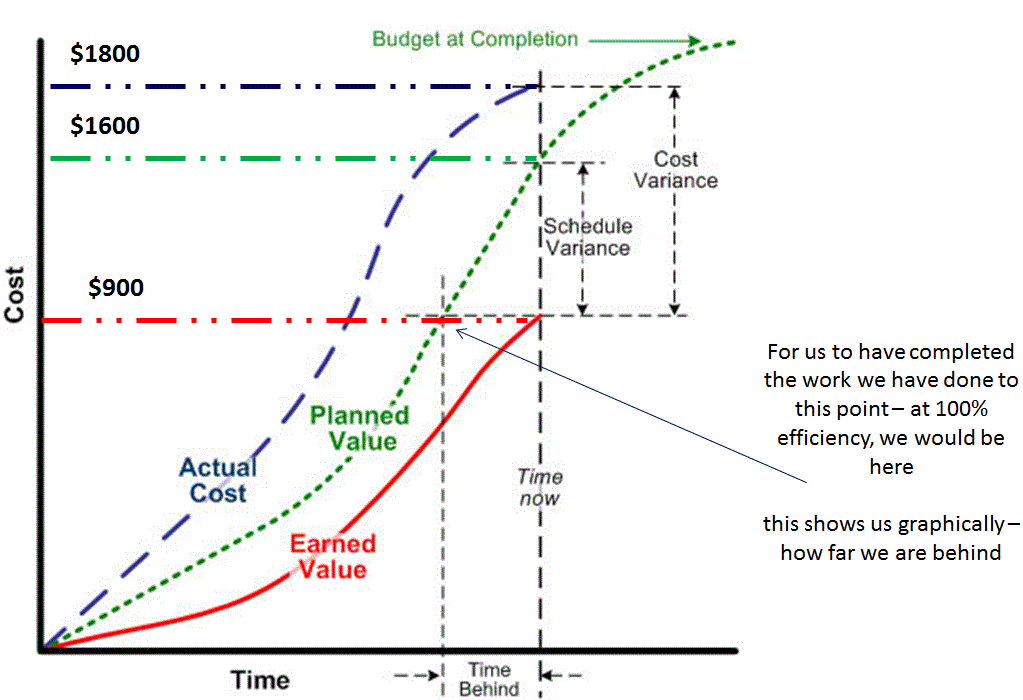
EVM measurements
EVM Measures |
Equation |
Schedule variance |
SV = EV - PV |
Cost variance |
CV = EV - AC |
Schedule performance index |
SPI = EV / PV |
Cost performance index |
CPI = EV / AC |
Cost variance - The difference between earned value and actual costs incurred.
- CV = EV – AC.
- - CV = The project is performing over budget.
- + CV = The project is performing below budget.
- 0 CV = The project is running on track
Example: Calculating schedule variance for a University Campus Build project.
- Total project budget is £425,800.
- £325,500 has to be spent by end of phase 3.
- Only £319,425 worth of work is completed.
- £319,425 (EV) - £325,500 (PV) = -£6,075 (SV) - project is behind schedule.
What does this signify?
Example 1
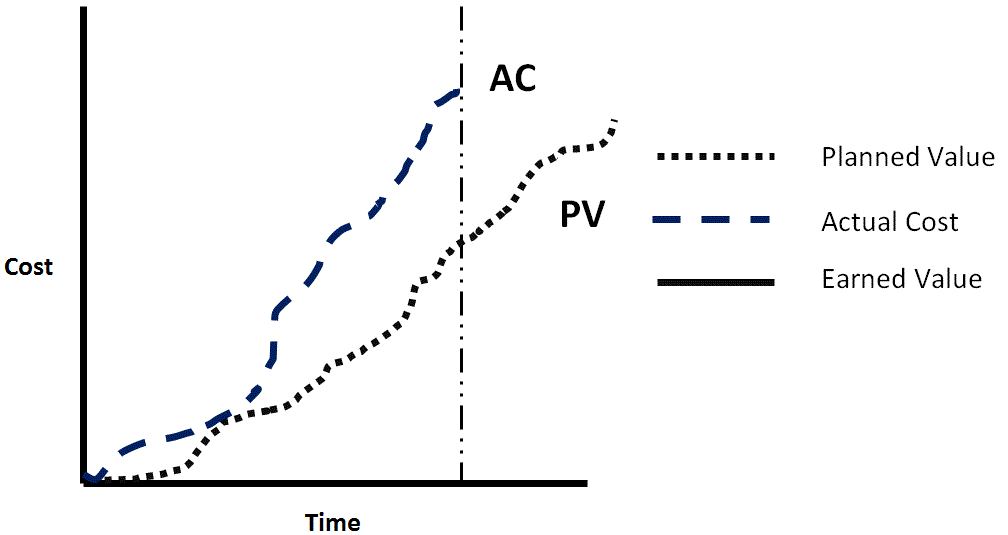
Nothing, there is no earned value line and we cannot determine the project status
Example 2
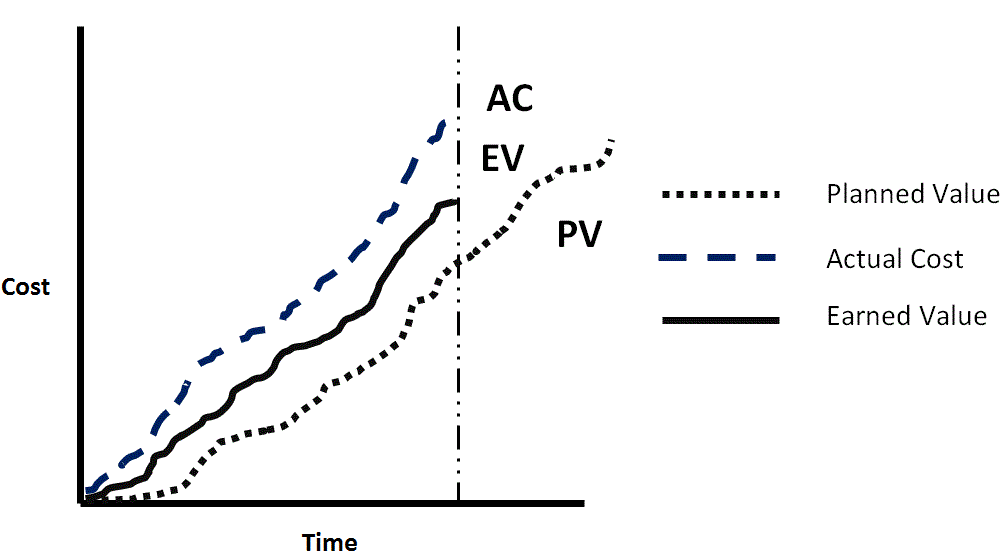
- Time CV = -
- SV = +
- Over-achieving, but overspent for the achievement
- Money being wasted, e.g. unnecessary overtime
Example 3
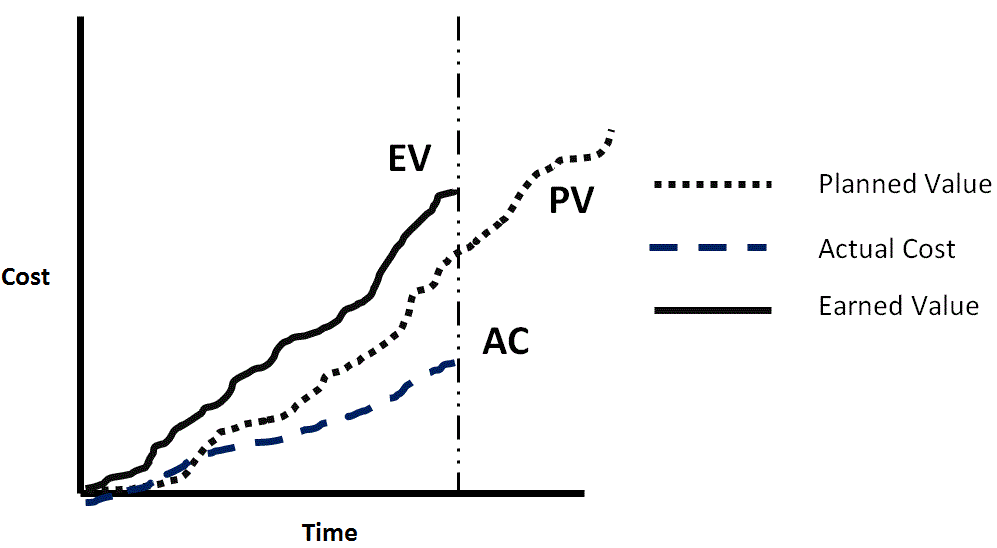
- CV = +
- SV = +
- Over-achieving, and underspending
- No action needed (unless there is an issue with NOT spending the customers money)
Example 4

- CV = +
- SV = -
- Under-achieving on the project, but overachieving for the spend
- Team performing well but under-resourced
Example 5

- CV = -
- SV = -
- Under-achieving on the project & overspending for the work done
- Team under-resourced and under-performing
Lets Have Some Fun
Our Project has:
- PV = £290,000
- EV = £260,000
- AC = £140,000
Formulae:
- SV = EV – PV
- CV = EV – AC
- SPI = EV/PV
- CPI = EV/AC
Work out:
- what this means for the project
- the SV
- the CV
- the SPI
- the CPI
Visualizing EAC, ETC and VAC
EAC = as of today, how much do we expect the project to cost?
ETC = how much more do we estimate the project to cost from today?
VAC = the difference between original total costs and new forecast total costs

Estimate At Completion
What do we currently forecast the total project to cost
4 formulae for different situations:
1. If we are 80% efficient and we don't know what the problem is, then we use this formula i.e. will carry on at 80% efficiency:
EAC = BAC / cumulative CPI = BAC/CPI
The word cumulative is used to denote the value at this point in time i.e. cumulative up to now.
2. If we are 80% efficient and we know what the problem is then we return to the budgeted rate and use this formula
EAC = AC + (BAC – EV)
3. If past assumptions are faulty then the PM or project team have no confidence in the original estimate for remaining work
EAC = AC + new bottom up estimate
4. This is used in special cases; considers both SPI and CPI.

There is an assumption that the project is over budget (negative cost performance) and the schedule has a completion deadline
ETC - Estimate to Complete is
Based on actual costs of work performed to date, need to calculate cost of work remaining
If things have not been going to plan (behind schedule and over budget) will/should the actual costs be used?
This formula covers all of the 4 EAC situations:
- ETC = EAC-AC
VAC - Variance at Completion is:
How different will the outturn budget be from the original forecast
- VAC = BAC - EAC
To-Complete Performance Index (TCPI)
What level of efficiency is required to be obtained, from the resources, for the remainder of the project
The performance level we should use from this point to get the project back to BAC (or EAC):
- TCPI = Remaining work / Remaining project budget.
- TCPI (BAC) =

- TCPI (EAC) = (BAC – EV) / (EAC – AC).
- TCPI value can either be >1 or <1
Don't forget that on completion:
VAC = BAC – AC
- This formula for VAC is when the project has finished “normally” according to its original forecast
- If it did not finish “normally” then VAC = BAC - EAC
SV= Zero
EV = BAC
DISCLAIMER
Firebrand Training grants you a personal, non-exclusive, non-transferable license to access and use the site. You may download or print material from the site only for your own personal, non-commercial use. Read our full terms and conditions on https://firebrand.training/uk/learn/terms-and-conditions.
 Part of the BPP Education Group
Part of the BPP Education Group